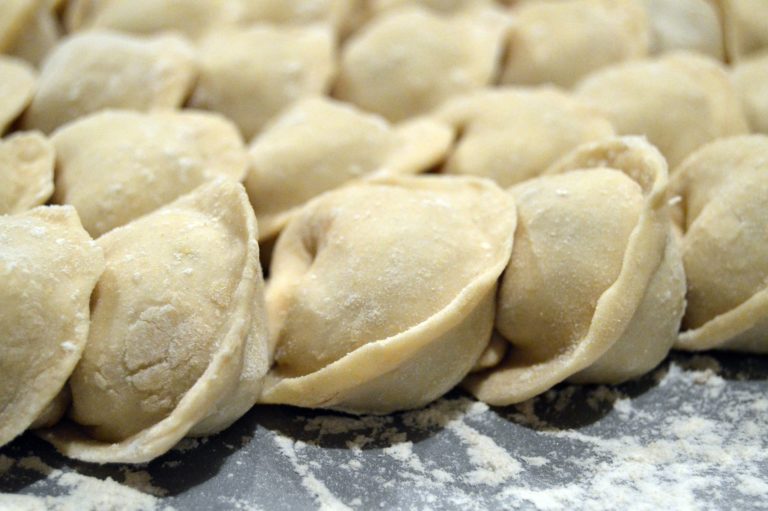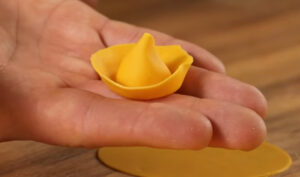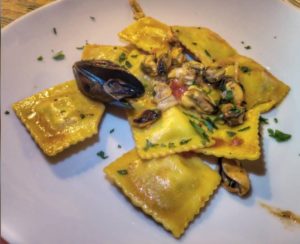 One of the reasons why Italy is very famous worldwide is certainly its cuisine. There are many regional Italian specialities, but first courses in general are the most noteworthy, and among these are filled pastas such as ravioli.
One of the reasons why Italy is very famous worldwide is certainly its cuisine. There are many regional Italian specialities, but first courses in general are the most noteworthy, and among these are filled pastas such as ravioli.
Depending on the region, ravioli can take on different names, including agnolotti, tortelli, cappellacci, pansotti and so on. Ravioli are thought to have been invented by a cook in ancient Rome, but more recent information dates back to the 12th/13th centuries when the first written records began to appear. They are even mentioned in Boccaccio’s famous Decameron!
As we move through the various regions of Italy, ravioli take on different names but also different shapes and fillings, we should also mention the sweet variants typical of Abruzzo and Sardinia. We can generalise by saying that ravioli consist of square or round cuts of pasta folded to contain a filling and can be seasoned in a variety of ways, below we will look at the main specialities of each region.
Piedmont – Agnolotti (classic and del plin)
A typical recipe from Monferrato sees donkey meat as the main protagonist of the filling, while in the Novara area borage is used, but whatever the chosen filling, the condiments most commonly used are excellent melted butter where sage is sautéed and then sprinkled over our dish with grated Parmesan cheese, roast gravy obtained from the meat cooking juices, or the classic condiment with Parmesan butter and a cascade of truffle shavings. It is worth mentioning the famous ravioli del plin, so called because of the special pinch closure that seals the mixed meat filling in the egg pasta.
Liguria – Pansotti
Typical filling of pansotti is made with ricotta cheese, parmesan cheese and a mix of wild herbs while white wine is used in the dough instead of eggs. The name is due to the swollen shape of the pasta, the origins of which are very ancient and date back to the tradition of the feast of St Joseph in which the Ligurians celebrated the Saint with a low-fat dish like pansotti. The typical sauce is made of walnuts and pine nuts.
Lombardy – Casoncelli
Born in the Brescia and Bergamo areas, they are also called casunziei or casonzieri in the local dialect. The ingredients of the classic dough are flour, eggs and salt, while the filling is made in the Brescia area with a mixture of meat and nutmeg, while in the Bergamo area salami paste seasoned with garlic, potatoes, spinach and cheese typical of the Bergamo valleys is used. They are seasoned with melted butter and local cheese typical of the Valleys
 Veneto – Casunziei
Veneto – Casunziei
This stuffed pasta is usually filled with beets and has a half-moon shape, they are typical of the mountain provinces of Veneto such as Belluno, it is a very simple peasant dish and is seasoned with melted butter.
South Tyrol – Schlutzkrapfen
The dough recipe uses rustic flours such as rye flour, eggs, oil and water while the typical filling is made with spinach, ricotta and potatoes but you can also find the addition of chives and poppy seeds. They are also known as Atesine ravioli, roffioi or rofioi
Friuli Venezia Giulia – Cjalsons
The ravioli typical of this region are a very poor peasant dish and the dough is made with potato flour and eggs while the filling can be made in different variations with ricotta and herbs, cooked onion, sultanas, dried figs and other ingredients typical of the Friuli Venezia Giulia valleys.
 Emilia Romagna – Tortelloni
Emilia Romagna – Tortelloni
The home of stuffed pasta is definitely Emilia Romagna where you can find many different types and different fillings from mixed meats to vegetables. One of the many fillings you can find is the typical candy-like one usually filled with a mix of ricotta and Parmesan cheese. Tortellini, small ravioli filled with mixed meats, are often served with cream or cooked in meat broth.
Tuscany – Potato Tortelli
As this vegetable is widespread in Tuscany, people found a way to use it to fill tasty ravioli, which are often served with a duck sauce.
Marche – Calcioni
They come either in a savoury version filled with ricotta cheese sheep’s milk cheese and herbs, usually served with a simple tomato sauce, or in a sweet version with a filling of ricotta, sugar and liqueur.
 Lazio and Molise – Cappellacci dei briganti
Lazio and Molise – Cappellacci dei briganti
They are so called because their shape is reminiscent of a bandit’s hat, the dough has a consistency similar to crespelle and they are usually filled with lamb ragout.
Abruzzo and Basilicata – Sweet Ricotta Ravioli
These are sweet ravioli whose filling is sweetened sheep’s ricotta cheese mixed with eggs, cinnamon, lemon rind and nutmeg, but the topping is either a tomato sauce or a mixture of melted butter and Parmesan cheese and are typical of the Carnival period.
 Campania – Ravioli alla napoletana
Campania – Ravioli alla napoletana
Filled using local cheeses such as ricotta and mozzarella combined with prosciutto in their most traditional version, but they can also be found with a vegetable or fish filling.
Puglia – Calzoncelli
Typical of the Christmas period, the dough made of semolina flour, water and eggs encloses a filling made of chestnuts, cocoa, honey and orange peel.
Calabria – Ravioli di stocco
The egg pasta of these ravioli is stuffed using stockfish with the addition of spinach, goat cheese and eggs, and they are generally served with a tomato sauce made from stockfish cuttings.
Sicily – Ravioli amari
With this unusual name, the Sicilians want to distinguish between savoury and sweet ravioli; in fact, bitter ravioli are stuffed with ricotta and herbs and served with a pork-based sauce.
Sardinia – Culurgionis
One of the most famous specialities of this region are these ravioli whose dough is made with water semolina extra virgin olive oil and salt while the traditional filling is made with potatoes, pecorino cheese and mint. Characteristic is the closure that almost draws a braid of dough along the edge of the ravioli.
